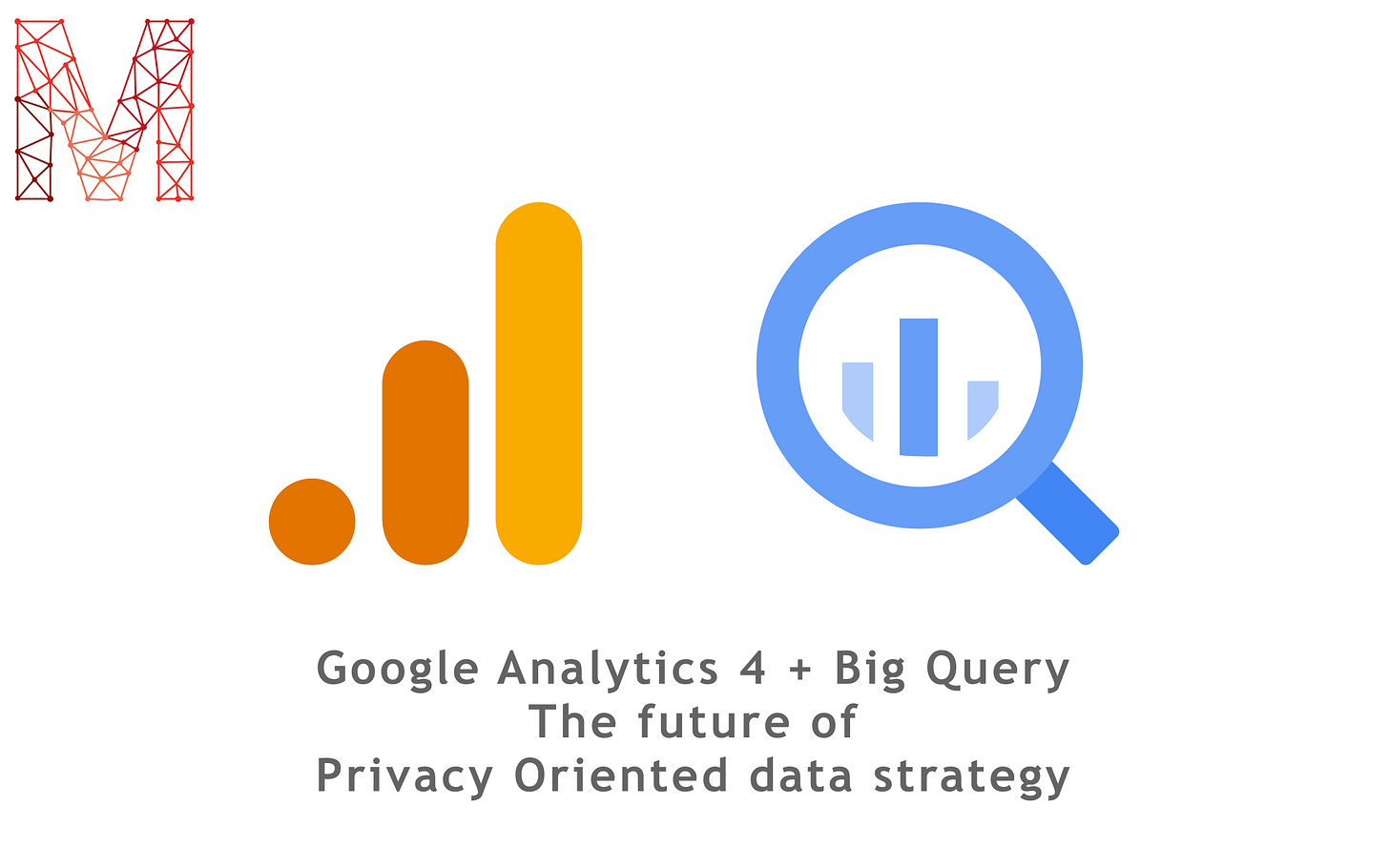Google Analytics & Big Query: the future of privacy driven advertising
How Integration among GA4, BigQuery and Offline data can support the future of advertising
In the rapidly evolving world of privacy-focused advertising, the integration of Google Analytics 4 (GA4) and Google BigQuery is emerging as a cornerstone for businesses navigating this new digital landscape. This partnership is vital in balancing deep analytics with user privacy considerations.
Behavioral Data and CRM Integration Through BigQuery
Merging user behavior data with Customer Relationship Management (CRM) systems via GA and BigQuery marks a significant shift in data analysis and marketing strategies. Central to this integration is the use of UserID in GA, pivotal for gaining a detailed, personalized understanding of the customer.
UserID in Google Analytics: Bridging Online and Offline Data
UserID in GA, a unique identifier assigned to each user, enables tracking user interactions across sessions and devices, providing a more accurate, consistent view of their behavior. Recognizing users accurately across different sessions and devices is crucial for understanding the entire customer journey, from product discovery to purchase, regardless of where and how the interaction occurs.
CRM Integration: A Holistic View of the Customer
Integrating UserID with CRM systems allows companies to connect online behavior data with offline information like purchase history, preferences, and demographics. This connection fosters a complete customer profile, merging their digital behavior with interactions through other channels. This holistic view is essential for developing targeted, personalized marketing strategies.
Enhancement with BigQuery: Detailed, Customized Analysis
Using BigQuery to analyze this enriched data takes analytics to a new level. BigQuery's capabilities in processing large data volumes and advanced analysis enable companies to conduct complex queries and derive deep insights from customer behavior. This not only improves marketing strategy accuracy but also predicts future trends and behaviors, optimizing resource allocation and campaign effectiveness.
Privacy Respect and Personalization
It's important to note that while delving deep into customer data, the integration of UserID, CRM, and BigQuery must be managed in compliance with privacy regulations. Companies must ensure user consent and handle their data securely and in accordance with existing laws.
Business Case: Fashion E-Commerce Company
Scenario: A renowned fashion e-commerce company, let's call it "ModaTrend," has a strong online presence and uses GA4 to track user interactions on its website and mobile app. ModaTrend also has a robust CRM system that collects customer data, including purchase history, style preferences, and demographic information.
Objective: ModaTrend aims to offer personalized shopping experiences and enhance the effectiveness of its digital marketing campaigns.
Data Integration: ModaTrend decides to integrate behavioral data from GA4 with its CRM data in BigQuery. This integration is facilitated by UserID, which connects online user activities (site visits, product views, ad campaign interactions) with their CRM profile (purchase history, preferences, feedback).
Using BigQuery: Once integrated into BigQuery, ModaTrend leverages its analytical capabilities to:
Segment Audience: Identifies customer segments based on purchase behaviors, style preferences, responses to previous marketing campaigns and customer lifetime value.
Personalize Shopping Experience: Develops personalized product recommendations for each segment, improving the relevance of offers displayed on the website and app.
Optimize Marketing Campaigns: Analyzes the effectiveness of different marketing strategies for customer segments, tailoring future campaigns to maximize engagement and conversions. Additionally, it benefits from platforms' ability to identify audiences similar to specific user groups.
Predict Future Trends: Uses predictive models to identify potential new fashion trends based on behavior and purchase data.
Results: With this integration, ModaTrend manages to:
Increase the relevance of product recommendations, leading to an improved conversion rate.
Optimize advertising budget allocation, focusing on the most effective channels and messages for each customer segment.
Enhance customer loyalty through a more personalized, satisfying shopping experience.
Quickly predict and adapt to changing fashion trends, keeping its offerings current and desirable.
Conclusion
In summary, integrating UserID in GA significantly enhances data analysis capabilities. Coupled with the use of BigQuery and synchronization with CRM systems, it offers businesses the ability to deeply understand their customers, personalize their marketing strategies effectively and respectfully towards privacy, and optimize customer experience in an increasingly interconnected and cross-device digital world. Google's integration capabilities extend to Google Ads, Search Console, and the entire marketing platform through Ads Data Hub, pushing the boundaries of analysis even further.
Previous Episode of: Next Advertising Era
News an Deep Dive
Ricerca di Optimove di come i consumatori percepiscono l’uso dell’AI nel marketing
Enhanced conversions in Google Analytics
The data Quality resolution Process by Mark Freeman
Google is going to be disable 3rdparty cookie to 1% of Chrome users on 4th January 2024
Meet the Privacy Power Players building the future of modern marketing



Thanks for sharing our article!